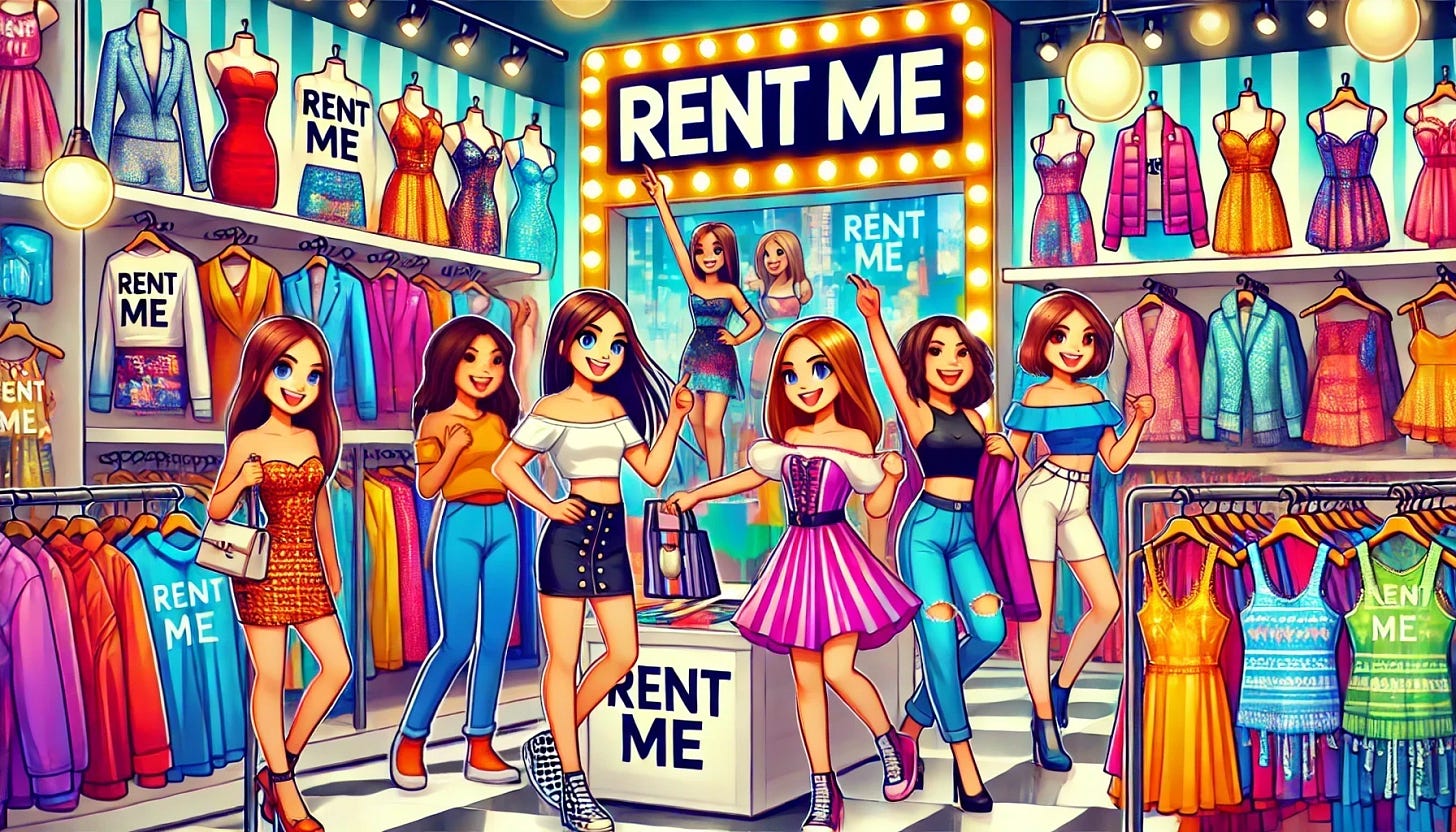PPPPrimed for Fall (Four Ps #244)
Redefining "Manhood," the Rental Economy, Rise of Social Commerce, and Swinging into November
🍂 Happy Fall, Everyone! (Unofficially, of course.)
If you love fall as much as I do, then today is like our New Year's Day. We made it! 🎉As we fall back into our post-Labor Day routine, here's what we've got:
🏫 Back-to-school vibes
🏈 Football weekends
🍁 Weather we can finally describe as "crisp" for the next two months!
And let's not forget... 🎃 Halloween, 🦃 Thanksgiving, and 🎄 the holidays are just around the corner!
But before we get ahead of ourselves, let's use this time to:
📝 Plan
📊 Prioritize
🗣️ Define our talking points for the weeks and months ahead.
Need time to think? No worries—I'll go first. 😉
THE PERSONAL: Fall into Fitness, Feelings Fatherhood 2.0
With my fantasy football drafts 🏈 behind me and a renewed commitment to diet and exercise already underway for fall (I’ll spare you the details of my calorie counting), I’ve also been focusing on another area for improvement: parenting.
👩🎓 This is the last year for each of my kids at their respective schools—Sydney is heading into 5th grade and finishing up elementary school, while Jake enters 8th grade. I don’t like to overshare about my kids too specifically (I’m not one of those parents), but I often think about the people they are growing up to be—their interests, personalities, priorities, and values.
While I’m not a new parent 👶, each stage of a child’s development is like becoming a new parent all over again—complete with new challenges, opportunities, and the occasional urge to Google “how to survive pre-teen mood swings.” 😅
📚 Many articles and books written in the last decade challenge traditional notions of manhood, embracing vulnerability, sensitivity, and empathy as essential human qualities. Leaders and role models have called for men to break free from limiting gender roles and redefine masculinity on their own terms.
👨👦 This same modeling behavior applies to fathers and sons, even if it means awkward heart-to-hearts at bedtime when all you want to do is collapse on the couch. 🛋️
As I watch my son grow into his teenage years, I strive to raise an emotionally communicative man, but I also can’t help reflecting on the pressures and challenges that come with it.
A larger question persists in my brain:
"What does it mean to be a 'man' these days?"
I don't profess to have the answer. And I may not always set the best example, but it’s not for lack of trying.
Sitting with him at an NWSL (women’s professional soccer) game last week, I didn’t want to overtly discuss the moral imperatives of supporting women’s sports or even gender equality. He’s seen and heard me talk about it enough to last a lifetime. But looking around the stadium, I noticed there weren’t many dads and sons in attendance.
What was he thinking and feeling? Perhaps the fact that he was watching the best in the world at what they do (eight Olympic gold medalists in the game!) was just as normal as being at an NFL or MLB game. 🏅 When we discussed it, it didn’t even register with him that this wasn’t always the case.
While that’s great news, I know he’s more advanced in his thinking than many others his age, and certainly older. In hindsight, I wish I had taken ten of his male friends and their dads to the game as well. Maybe next time I'll rent a bus. 🚌
Thinking back on my own experiences, the friendships, and the behaviors I emulated at his age, I was wholly unaware that I was conforming to an underdeveloped notion of what it means to be a man. Society teaches boys to disconnect from their emotions, something even a caring father can struggle to address.
So what does it mean to be a "man?" It means being huMAN. (See what I did there?) It means being a force for good, rooted in compassion, empathy, kindness, and equality, but also mental toughness, confidence, persistence, and self-motivation.
While the outlets and platforms have changed, boys of a certain age still battle feelings of inadequacy, shaped by early struggles in school and societal expectations of male intellect. It reminds me that I need to encourage my son to embrace his unique talents and seek help when he needs it, rather than feeling pressured to have all the answers. 🧠 So here’s what I want:
To equip him with the tools to navigate a world that often equates masculinity with suppressing emotions and putting on a brave face, even when fear looms large. And let's face it, the world doesn’t exactly make this an easy task.
For him to know that real strength isn’t about hiding vulnerabilities but about sharing them with those who care about you—because nothing says “I’m strong” like admitting you’re terrified of that spider in the bathroom and asking for backup. 🕷️ I hope to create an environment where he feels safe expressing his fears and insecurities without judgment.
He should understand that wisdom isn’t about knowing everything but about knowing when to lean on others and admit when he doesn’t. Ultimately, true strength and intelligence lie in self-confidence, situational awareness, and supportive collaboration. 💪
To have the patience to guide him toward a path where he feels confident being himself, open to vulnerability, and unafraid to ask for help. Or at least unafraid to ask where I’ve hidden the last of the snacks. 🍪
To grow into a good man, one who knows that his worth isn’t measured by his toughness but by his ability to be kind, thoughtful, and true to himself—spiders and all.
THE PRACTICAL: Fall Into Financial Flexibility
🛒 Consumers are undergoing a fundamental shift. Yes, again.
Honestly, I don't even know what "consumers" means anymore given how fragmented we are... but I digress.
One of the bigger things we're seeing: Consumer behavior is merging with "renter behavior."
🔄 We often talk about consumers in traditional terms, assuming they're purchasing products outright. But what if they're not buying at all? (They're certainly not buying at Dollar General at the moment)
What if the new norm is renting, even for items as basic as clothing or furniture?
This emerging rent-first mentality is more than just a trend; it’s a significant driver of socioeconomic change and even inflation—something most people aren't discussing.
🏡 In a market where owning a home feels like an unattainable dream for many, especially younger generations, the idea of ownership is taking a backseat.
Instead, people are opting to rent nearly everything, from cars to jeans.
It’s not just about convenience; it’s about financial strategy. Renting offers flexibility and the chance to allocate resources toward investments that might appreciate over time, like education or stock portfolios.
💳 Gen Z is the most stressed generation about personal finances, with their top financial priority being to build good credit, according to PNC Bank's Financial Wellness in the Workplace Report. Despite their focus on credit, Gen X is the least likely to have worked with a financial planner, often feeling they lack sufficient funds to do so.
However, this more reserved mentality might have far-reaching consequences.
📉 As more people adopt a rent-first lifestyle, demand for durable goods could decline, potentially stunting economic growth. Meanwhile, services and rental markets inflate, driven by increased demand.
This shift also contributes to a broader inflationary pressure, as the cost of renting goods and services rises in response to growing dependence on temporary ownership.
🎄 And as the holidays approach, brands, marketers, and businesses have high expectations. Maybe too high. They should brace for a potential shift in consumer spending behavior.
Unlike the record-breaking e-commerce sales of recent years, this year might not see the same growth. Back-to-school shopping trends, often a reliable indicator of Q4 sales, suggest a more cautious consumer mindset.
📊 The National Retail Federation (NRF) predicts that this could be the first year in a while without record-breaking sales, as consumers grapple with the impact of rising prices and an economic slowdown, adding to their uncertainty.
Inflation-adjusted revenue projections paint an even bleaker picture.
To navigate this challenging landscape, marketers should prioritize:
🎯 Precise targeting
🤝 Personalized campaigns
💡 Compelling offers
These strategies are essential to maintaining shopper interest.
And we can probably expect a broader dip in the travel market, at least with some demographics deeming "travel is too expensive" is becoming a common sentiment.
✈️ Discretionary spending on experiences like vacations and concerts is dropping. In this case, they're not even renting... they're just staying local.
This reduction in spending, particularly among Gen Z and millennials, suggests a broader trend of financial caution—possibly an early warning sign of deeper economic issues ahead.
😲 Seems like a curious time for such a large percentage of Gen Z to be considering quitting their jobs.
Apparently 39% of GenZ workers plan to quit their jobs in 2024, significantly higher than the 25% average across all age groups. Additionally, 43% of workers, particularly younger generations, intend to ask for a raise in the coming year.
Of course, if all else fails, they could take on a side gig as "pizzafleuncer" for Pizza Hut.
Questionable jokes aside, we're seeing a generational turning point—a socioeconomic wave that could reshape markets and economies in ways we’re only beginning to understand.
THE PROFESSIONAL: The Fall of Social Media 1.0 and the Rise of Shopping Commerce
🛍️ Speaking of shopping...
Social shopping is no longer a fringe trend—it's becoming a powerhouse in the e-commerce world.
📲 With the rise of platforms like Instagram, TikTok, and Facebook, the convenience of buying directly from your feed is reshaping how we shop.
How many times have you been scrolling and seen something that you just had to buy? It could have been a branded post, an ad, or even something someone in your network was talking about (we call this "social proof").
📈 The stats back it up: The number of U.S. adults likely to purchase through social media continues to rise every quarter. Between just two quarters in 2024, there was a noticeable uptick in positive sentiment towards social commerce.
This shift isn't just happening on one platform; it's across the board—except for X, which has seen a dip, likely due to reduced ad spend and other factors.
Surprisingly, Snapchat leads the way for social shopping in the U.S., with 16.3% of shoppers using it at least weekly, surpassing Reddit, TikTok, Instagram, and Facebook.
Snapchat: 16.3%
Reddit: 16%
TikTok: 10.7%
Instagram: 8.2%
Facebook: 4.4%
Although the exact number of respondents for these statistics isn't clear, these trends are worth considering for potential adjustments in your social shopping strategy.
💡 For brands, especially in apparel and beauty, the message is clear: If you’re not leveraging social shopping, you're leaving money on the table.
But there's a catch—the potential of social shopping, while vast, is capped.
Why? Traditional social platforms still suffer from one major drawback: high bounce rates. Users might browse, but they don’t always buy. And that’s where the opportunity lies.
Enter Genuin’s Community Media Network—a game-changer for brands looking to uncap that potential.
Unlike traditional social media, Genuin offers video-powered communities where brands have full control. This means no more battling algorithms; instead, you get to craft your content, engage with your audience directly, and build genuine communities.
The result? Longer session times, deeper engagement, and higher ROI. Plus, with complete data transparency, you can make informed decisions that keep customers coming back.
🔍 So, while social shopping is growing, smart brands will look beyond the scroll and tap into communities where the real engagement happens.
THE PODCAST: The Publicis Purchase and What's Next for Ryan Detert
Scoring the first podcast interview with Ryan Detert after the company he founded a decade ago, Influential, was purchased for an incredibly large sum of money.
THE POLITICAL: Fall into the Future
Look at your calendar for a second, and then consider what is exactly two months away. That's right, it's the U.S. Presidential Election. And as we get closer to the opening of early voting in just a few weeks, it's clearer than ever that this election will ultimately be decided by swing voters in five or six states.
Most states consistently vote red or blue — between 2000 and 2016, 38 states voted for the same political party — but swing states are less predictable.
And the remaining undecided voters in those states are about to become the most popular kids in the electoral playground.
🗳️ How anyone can be unclear on how they want to vote at this point is beyond me, but it’s such a narrow focus at this point that talking about anything else is almost irrelevant.
While most states are as predictable as your morning coffee order—think Texas going red and California blue—there are a handful of states where voters still have their minds wide open. These swing states, including perennial favorites like Pennsylvania, are where the real magic (or chaos, depending on your perspective) happens.
With 38 states having voted consistently for the same party between 2000 and 2016, the real action is confined to just a few places that could go either way.
🤔 What makes swing voters so interesting (and, let’s be honest, a little nerve-wracking) is that they’re not exactly glued to political news. They’re more like casual observers at a sporting event, showing up when the stakes are high and the action is too good to ignore. This means candidates have to pull out all the stops to grab their attention.
For Kamala Harris, this might involve a mix of serious policy discussions and some creative, attention-grabbing stunts.
Picture this: Harris on “Hot Ones,” casually discussing the importance of Medicare while handling a fiery hot wing. 🌶️ Or maybe ordering a Starbucks pink drink while making a point about taxing the rich. The possibilities are as endless as the election memes that will undoubtedly flood your feed.
Beyond the humor, there’s a serious undertone.
📉 The percentage of swing voters has nearly halved since Joe Biden bowed out, signaling that Harris might be doing something right by appealing to moderates with her populist economic policies. These voters are not just fence-sitters; they’re the final decision-makers in what could be one of the most consequential elections in modern history.
So, as we gear up for a fall for the ages, the final stretch, keep an eye on those swing states and their indecisive voters.
They may just hold the key to the future of the nation. 🔑
And in the meantime, Vice President Harris, if you’re reading this—maybe give that “Hot Ones” appearance some serious thought. Just saying. 😉
Wishing you a great start to fall…









